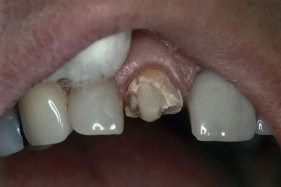This article discusses failures that could occur if meticulous attention is not given to details such as planning the case, conservative (enamel saving) preparation of teeth, proper selection of ceramics to use, proper selection of the materials and methods of cementation of these restorations, proper finishing and polishing of the restorations, and proper planning for the continuing maintenance of these restorations. Some concerns as to newer products and methods and their effect on the continued success of this modality of treatment are also addressed.
Since its introduction more than two decades ago , etched porcelain veneer restoration has proved to be a durable and aesthetic modality of treatment . These past 25 years of success can be attributed to great attention to detail in the following areas: (1) planning the case, (2) conservative (enamel saving) preparation of teeth, (3) proper selection of ceramics to use, (4) proper selection of the materials and methods of cementation of these restorations, (5) proper finishing and polishing of the restorations, and (6) proper planning for the continuing maintenance of these restorations. This article discusses failures that could occur if meticulous attention is not given to such details. Failures that did occur structurally and aesthetically warned individuals who were learning the procedure what to watch for. Some concerns as to newer products and methods and their effect on the continued success of this modality of treatment are also addressed.
Shade matching
Aesthetic shade matching and masking with thin porcelain veneer restorations are arguably the most demanding facets of this procedure. The key to success is understanding that the final color obtained is a combined metamerism of the tooth, the resin cement selected, and the porcelain used for the restoration.
The first part of the equation—the underlying tooth—can play a crucial role in the final appearance of the restoration. Imperfections should be minimized, and existing restorations should be changed either before preparation and impression making or at the time of insertion. The clinician also may try to change the color of the teeth to be veneered (ie, tetracycline-stained case) with the use of modern bleaching techniques . The final opacity, translucency, and distribution of color of the existing tooth (the stump shade) should be communicated thoroughly to the technician by intraoral photographs, shade drawings, and custom shade guides to allow the technician to plan the most important part of the equation, the final restoration. Masking undesirable discolorations without sacrificing natural translucency in the final restoration requires technical skills and experienced workmanship that can only be tapped if the technician receives enough information about the case. Using contemporary feldspathic porcelain (Omega900, Vident, Brea, CA; Finesse, Dentsply Prosthetic, York, PA; IPS, D.Sign, Ivoclar Vivadent, Amherst, NY) and metal-free, high-strength restorations (IPS Empress, D.Sign, Ivoclar Vivadent, Amherst, NY; OPC, Pentron Laboratories, Wallingford, CT), which are developed specifically for bonded restorations, dental laboratory professionals are able to vary translucency and internal characterizations in the fabrication of aesthetic restorations. The technician’s experience and ability are of vital importance to a successful case.
The last component of the equation is the luting cement. Under normal circumstances, the cement is probably the least responsible for the final result obtained, contributing less than 10% of the final color of the restoration. There is an important contribution, however. Generally, the higher the filler content of cement, the more refractive and opaque the final color of the restoration. If the laboratory technician incorporates a spacer on the die on which the veneer is fabricated, this important component of the process can be addressed. The resultant increase in distance between the tooth and the veneer allows for increased control of the restoration color with resin cement. The value and opacity of the underlying cement are generally more important than the hue or chroma selected . It is the authors’ experience that thin viscosity, highly filled resin cements cause fewer long-term problems with marginal discoloration and air entrapment than do more viscous resin formulations. Recent-generation resin cements (eg, Calibra, Dentsply Caulk, Milford, DE; Choice II, Bisco, Schaumburg, IL; Lutelt, Pentron Corp., Wallingford, CT; Variolink I and Appeal, Ivoclar Vivadent, Amherst, NY; Ultra Bond Improved, Den-Mat Corp., Santa Monica, CA) can be light cured or, if used with thick restorations such as inlays, onlays, or crowns, dual cured with the addition of catalyst added to the base cement. It should be noted that once the dual-cure component is added, the likelihood exists that the restoration may change slightly in color over time because of the aromatic tertiary amine component of dual-cure products . Dual cure resin cement use should be limited to posterior restorations outside the smile line.
In instances in which classes III and IV restorations that require replacement are in contact with the veneer preparation, the authors also had success with microhybrid restorative resins used as cements (ie, TPH Spectrum, Dentsply Caulk, Milford, DE; Venus, Heraeus Kulzer, Armonk, NY; Point 4 Sybron/Kerr, Orange, CA). These resin cements are opaque enough that they are also useful in masking stained teeth (ie, tetracycline-stained cases). Clinicians should take care to properly provide a better contact angle of these more highly viscose materials to the veneer. This is accomplished by first applying a thin layer of a light-cured unfilled resin to the veneer and then syringing the hybrid directly on the intaglio (ie, internal surface) of the restoration. A composite instrument is used to flatten the hybrid over the surface so that no air is trapped. The restoration should be seated slowly and with pressure to ensure complete seating. Any excess resin cement is removed with a microbrush soaked with unfilled resin. Finally, the veneer is pushed into place one last time. Excess resin is left in place to ensure that there are no voids at the margins. While slight finger pressure is applied, the restoration is cured for at least 5 seconds with a standard halogen or LED light, after which finger pressure is no longer needed and the curing of the resin cement is continued for additional 40 seconds. These restorations cannot be overcured, so more curing time is better than less curing time.
Marginal discoloration and loss of color stability
The least common problems associated with porcelain laminate veneers are marginal discoloration and loss of color stability. These problems seldom occur because (1) all margins are in cleansable areas often easily finished and polished at the time of cementation and (2) the glazed porcelain surface, which is mostly impervious to extrinsic stain, also protects underlying light-cured (more color stable) resin cement .
If a well-fitted restoration has been returned and a thin viscosity, but highly filled, resin cement has been used with proper finishing and polishing techniques, immediate marginal discoloration is rare, and little or no marginal discoloration is usually seen at long-term follow-up. However, ill-fitting veneers, which expose inappropriate amounts of resin cement at their margins, or well-fitting but poorly seated restorations caused by the use of highly viscous cements often show a dark line stain at the margins ( Fig. 1 ). Only refinishing and repolishing can remove these dark lines. If these lines are too deep, then a replacement restoration may be necessary. To remove excess cement, the author uses a series of trimming diamonds (ie, ET, Brasseler USA, Savannah, GA) in a 30-μm, 15-μm, and 8-μm sequence of finishing diamonds. (The Two-Striper MFS, another kit of diamond finishing instruments by Premier Dental, Plymouth Meeting, PA, comes in 40-μm, 20-μm, and 10-μm series.) This process is followed by finishing and polishing with strips and disks (ie, Sof-Lex, 3M Espe, St. Paul, MN) and then by porcelain diamond polishing paste applied with rubber cups.
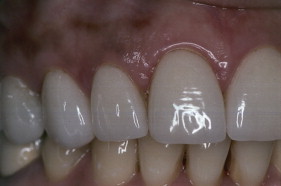
Marginal discoloration and loss of color stability
The least common problems associated with porcelain laminate veneers are marginal discoloration and loss of color stability. These problems seldom occur because (1) all margins are in cleansable areas often easily finished and polished at the time of cementation and (2) the glazed porcelain surface, which is mostly impervious to extrinsic stain, also protects underlying light-cured (more color stable) resin cement .
If a well-fitted restoration has been returned and a thin viscosity, but highly filled, resin cement has been used with proper finishing and polishing techniques, immediate marginal discoloration is rare, and little or no marginal discoloration is usually seen at long-term follow-up. However, ill-fitting veneers, which expose inappropriate amounts of resin cement at their margins, or well-fitting but poorly seated restorations caused by the use of highly viscous cements often show a dark line stain at the margins ( Fig. 1 ). Only refinishing and repolishing can remove these dark lines. If these lines are too deep, then a replacement restoration may be necessary. To remove excess cement, the author uses a series of trimming diamonds (ie, ET, Brasseler USA, Savannah, GA) in a 30-μm, 15-μm, and 8-μm sequence of finishing diamonds. (The Two-Striper MFS, another kit of diamond finishing instruments by Premier Dental, Plymouth Meeting, PA, comes in 40-μm, 20-μm, and 10-μm series.) This process is followed by finishing and polishing with strips and disks (ie, Sof-Lex, 3M Espe, St. Paul, MN) and then by porcelain diamond polishing paste applied with rubber cups.
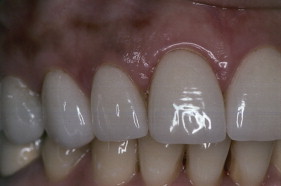
Breakdown in bonds
A possible cause of marginal discoloration and the loss of color stability of the restoration is marginal leakage or a breakdown of the bond either between the cement and the tooth or between the cement and the veneer. This discoloration starts as a dark line but eventually works its way under the restoration, with a resultant diffused discoloration that spreads from the involved margin. This phenomenon was common with acrylic laminate veneers as a result of the poor bond strength at the cement and acrylic veneer interface. This separation is uncommon for porcelain veneers because under normal circumstances, the bond to porcelain by the cement and the bond of composite cement to tooth is more than acceptable to retain the veneer over the long-term .
However, if the veneer is not properly etched or if the veneer and tooth are in some way contaminated during the bonding process (ie, water or oil in the air lines), it is possible to experience this problem or worse—the complete delamination of the veneer. This occurrence is rare, and it is usually important to pay close attention to the porcelain, composite, and tooth interfaces ( Figs. 2 and 3 ). Organization of steps at the time of bonding usually eliminates this concern. If a debonded but good-fitting restoration is recovered, the tooth may be cleaned of all old composite using magnification. The intaglio of the restoration intern can be delicately sandblasted and re-etched using hydrofluoric acid and then cleaned, silanated, and recemented.
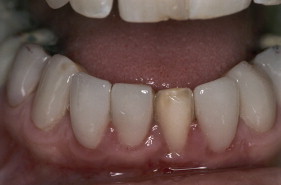
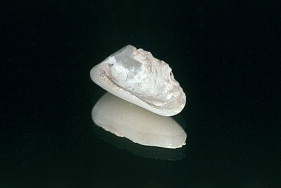
Air bubble entrapment
Air bubbles can become entrapped near the margin of the restoration, which eventually becomes exposed. Food and other debris may be packed into the small space between the restoration and the tooth. Although this is a rare occurrence, the best treatment is first gaining proper access to this void with a pointed diamond and thoroughly removing any food and debris impaction. The porcelain can be etched with mild hydrofluoric acid and silanated, the tooth can be etched with 37% phosphoric acid, and a new resin cement can be introduced with a thin syringe tip or compule.
Leaking, old restorations or an uncovered surface of the veneered tooth also may cause generalized discoloration. This possibility should be examined, and if it is found to be the cause of any discoloration, the restoration should be removed and restored ( Figs. 4 and 5 ). There has been some speculation that dual-cured or chemically cured composite resins used as cements for veneers eventually can discolor over time, with resultant change of veneer color. Modern porcelain veneer cements are generally packaged as base shades only and are light cured. Some of these cements can be used in conjunction with the appropriate catalyst to be used as dual cements, but they should have limited use on posterior restorations outside the smile line.
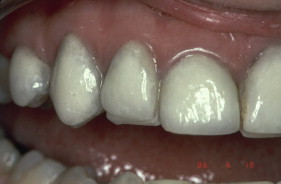
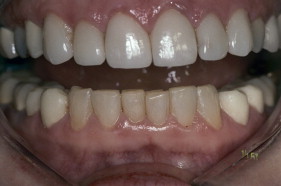
Cohesive failure and repair
Another rare occurrence is the cohesive failure of either the tooth or the porcelain. In the first instance, the fracture of the underlying tooth is usually the result of poor judgment in selection of the tooth to be veneered. Vital anterior teeth with large existing restorations on the mesial and distal surfaces might be better served with full-coverage porcelain restorations bonded to the additional surface area of the crown preparation on dentin. Nonvital anterior teeth that have at least one surface with large existing restoration and an average-to-large lingual access from root canal therapy should be considered for post core and full-coverage porcelain crowns ( Figs. 6 and 7 ) .

